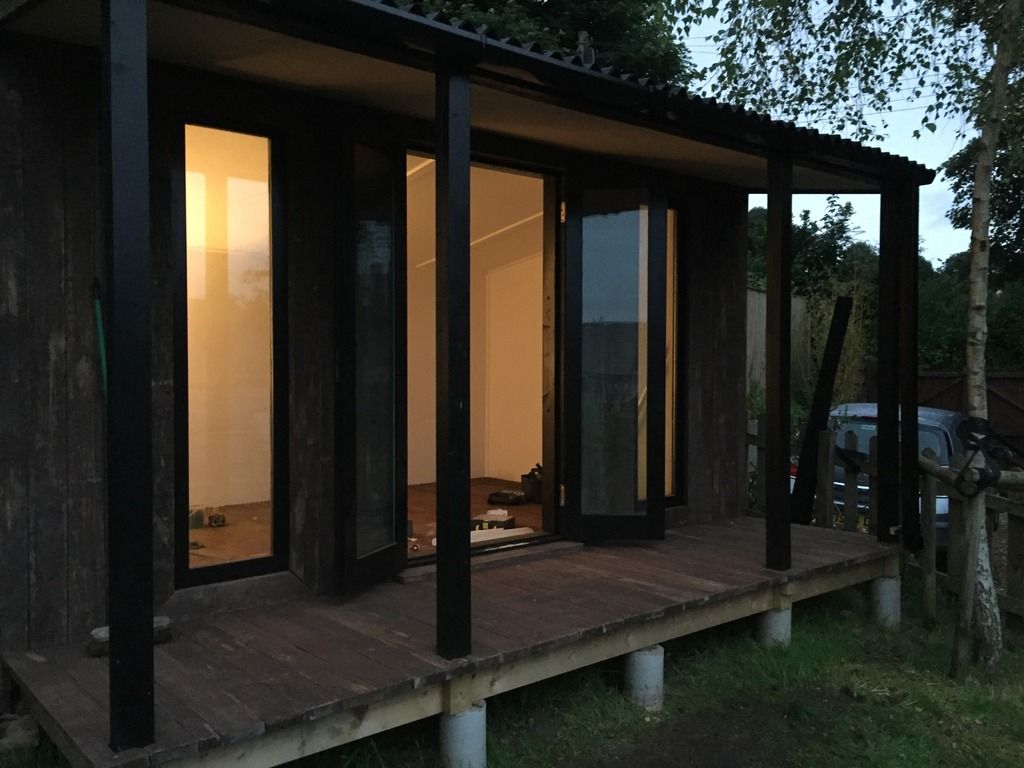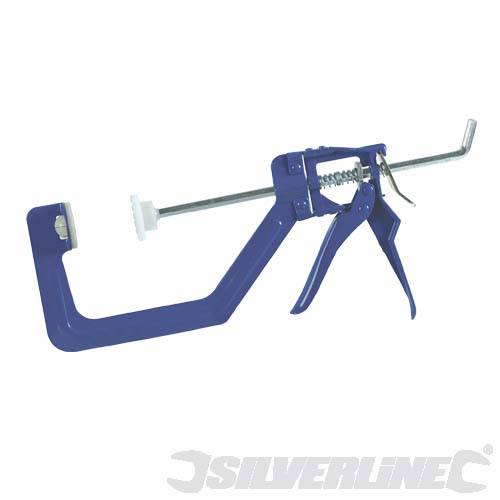..... me to build something decent with absolutely no woodworking experience whatsoever, relying on advice from here?
ive an area in my garden thats just going to sh1t and is getting overgrown with weeds. it used to have a shed that rotted away so i burnt it, had a 3m X 3m concrete base put down by builders when they did our extension, and has never been used.
ive included a few photos for context including sizes. ideally id like a small shed next to garage, and the rest to be a gazebo/seating/barbecue type area with an open end onto the fields to make the most of the view.
builder has quoted me £1800 for something along those lines. is it worth me considering something myself, or will the pain involved make it worth my while paying the extra for an expert to build it? if the materials cost over a grand anyway, then its probably not worth my while, but id get a heap of satisfaction if i could pull it off and build something myself.
no comments about the state of the garden please 
advice much appreciated, its either me or the experts. if its me id love some advice on exactly what id need, materials, tools etc.
thanks a lot
Been looking at doing similar to keep my bikes in and brew beer, my base is a bit bigger (3.6x4.7m).
1-2 courses of blockwork (splash zone and my base is imperial level so the blockwork will get me real level), then stick built (as per american houses 18" spacing) with a lightweight insulated roof (looks like tiles, but are in fact big self supporting sheets). Sparky for the plugs and the like.
Roof apex is 9', wall height away from the house is 8' to allow bikes to be stacked 2 high and closest wall is 7' high.
I have a circular saw, compound mitre saw (make stuff like this a breeze), makita drill with extra battery pack, roofers mitre and a lot of troplicalised wood screws (get good screws, go in so much easier).
My budget is e4K, as it's really hard to get as many bargains in ireland (still pondering making or buying a security door). The tools all up cost ~£350.
These days we are all able to access online tutorials and videos about doing virtually anything. I'd say absolutely have a go!
On your own property you also have the luxury of taking your time and so are able to scavenge for free to use materials.
There is endless information and resources for help out there and plenty of folk only too willing to help out where they can so yeah, have a go.
First port of call might be to find some images of other structures you like or do a few rough sketches just so that you can start putting forward ideas of the sort of thing you want.
Very happy to help if I can and you'll get much greater sense of achievement doing something yourself.
Yes of course you can. STW is a great source for info as is Google. Just take your time, research, budget, budget & budget. Find friendly local suppliers & visit when they're not busy. So much cave potential right there.
ok thanks, ill dip me toes in then 
thanks
just thinking...... we got a pile of gravel out the front of the house thats left over from the edge of the drive. would it be a good idea to shovel it all over the 'uneven ground' part of the plot and building it up to the 'flat concrete square' level? thered be nothing holding it all in, but would it be better to work with than whats there now?
EDIT: just been out for another look and i dont think theres enough, but is it still a good idea to use it to make a flat area anyway, itd just be lower and require building up with more wood. or should i just build it up with wood anyway and forget about the gravel?
EDIT EDIT: a quick google images show the sort of thing i had in mind but with a walled back too. smaller shed area than that tho, maybe not as grand. also maybe joined onto back of garage and with whatever roofs easiest to do.
[img]  [/img]
[/img]
seems ambitious when i look at it now :-/
Im in the process of laying out a concrete base for my self assembly shed coming in 10 days.
I've already dug the base out, will concentrate on levelling it this weekend, then filling with old bricks & hardcore before framing it out and topping it with 4" concrete for a level base.
Then comes the shed building......
Sorry there were too many disclaimers and as a result we need to see photographs of the rest of your garden to prove that this is the only neglected bit.
Oh, and it's a good excuse to buy loads of tools...
thestabiliser.
Your last picture is the Wolvo Tramp.
He used to keep the central resevation he lived on immaculate.
Always cleaning up shit that people though was ok to throw out of their cars.
Go for it. There's not a lot that can go wrong. If something looks right, it generally is. You wont need much in the way of tools. A spirit level, tape, a square, saw, hammer and nails. Some G clamps are invaluable for assembling things single handed. There's a lot of good advice to be found on here. Never be afraid to ask.
^^^^
A set of 4 big g-clamps were probably the most useful tool for the whole build.
But a battery powered circular saw was really bloody useful too...
right, ive been chatting to friends, reading online, asking about, i now have some idea of how im going to do this.
first things first, the base.
rather than have a flat base, im going to have a sort of 'floating floor'. 8 thick columns concreted in about 2 ft deep (above pic shows the sort of thing i mean ^^^), screw 5X1 sections to them to make the outside square base, then more 5X1 cross beams also screwed to that square in maybe half metre intervals. then support all the wood thats 'off the floor' with bricks, blocks of wood, anything really as it wont be seen. thatll give me the base for a load of decking planks to go over the top for the floor.
so thisll take me to the point where i have a floor plus 8 'big columns' sticking out of the ground.
does this sound a decent plan?
Concrete piles are an easy way to level up a site. I had an 18" drop across the site I built that shed.
Cardboard postal tubes are the best way to form them. I got mine from defendapak
that sounds a neat trick. obviously at the time you dont know what size piles you want til the frames been built and supported with bricks/stones etc. is that what you did, then measure each drop needed, cut tubes to match and fill with concrete?
also whats the ideal wood for me to buy for this, tanalised, pressure treated etc. id like as little maintenance as poss later, but cost is also a factor.
also just out of curiosity, what did you need the g-clamps for? i can only see bits of wood needing cutting and screwing together, not sure where these would be needed.
Dig the holes, put the tubes in, get them level across, fill with concrete. Wait til they've set and then build a wooden frame on top.
G-clamps are handy for tacking stuff together until your ready to fix them. Like a second/third pair of hands when you working on your own.
I used c16 pressure treated timber for the shell of mine, 6x2 for the floor, 4x2 for the walls and roof. Got the 6x2's dirt cheap at b&q as they were clearing out 4m lengths at less than half price. 4x2's were from wickes which seemed to be best balance of price & quality.
Dig the holes, put the tubes in, get them level across, fill with concrete. Wait til they've set and then build a wooden frame on top.
ahhh im with you. good thinking that, although with my gazebo design ^^^ id have to put in long posts to support the roof anyway so cant use the tube method. i plan to end up with 8 posts to roof height, dug around 2ft into the ground and concreted in.
Search for some of mcmoonters threads then. That was my other approach I considered. Vertical posts with a ring beam top and bottom tying it all together.
just been searching but only found one thread that was relevant to me, and the great man did indeed advise 4X4 posts a foot or two down and to use them for cladding to. thats my plan for the shed end as it doesnt matter too much about looks, so normal fence panel overlap wood will do for that. the gazebo id like to look a bit nicer but not sure what my options are for the two walls, might end up being the same i spose.
Vertical posts with a ring beam top and bottom tying it all together.
not sure what a ring beam is but do you just mean lengths of 5X1 or summats screwed to the posts in a big square top and bottom? so making a cube in effect?
thats what im planning to do, with a load of lengths going across too, to sit decking planks on.
my first concern i think will be the prep for the base. ill string it out i think but then i need to make sure the holes are dug to line up exactly. then the big problem for me will be having to have 8 posts stuck 6ft or so out the ground and stabilised exactly so they dont move when concretes setting.
any tips for that?
Try this one.
thanks. shame hes removed pretty much all of the pics but theres enough there to encourage me im thinking along the right lines. its also changed my mind about concreting the posts, apparently they rot quicker, so ill stick em in soil. im thinking with the top and bottom screwed to the posts, plus the cross beams itll be reet
probably easier to get plumb as well and not such a disaster if i need to relocate one slightly.
quick question as i think of them.... should i use some sort of angle bracket to screw planks to these posts, or just simply 2 screws each end into the posts?
thanks
There are some pics here in my blog
http://www.petermclarenfineart.com/Blog/Studio-Build-Blog
To get the posts in line, stretch some builders string as tightly between two pegs about six inches above the ground. Dig your post holes along the line with say the outside edge of your posts touching the line. If they are out of line they will deflect it. It's an easy way way to check.
An easy way to space the distance between your posts is to cut length of wood to the space dimension then nail that to a longer length leaving tabs at each end that you can clamp to your vertical posts. If you make a pair of spacers, one fir the top and one for the bottom you should be able to keep the verticals parallel more easily. Temporarily cross brace the posts as you work along the line then move the spacers to the next gap. Once you have them all in line clamp and nail your bottom rail and top rails along the line of posts.
I usually nail rather than use screws. A good timber merchant should sell you a 25kg box of nails for around £30
Keep it level and square at all times it will make your job so much easier ...just built a 13 ft x 8 ft chillout space cost altogether about £800
Firstly £1800 sounds cheap. Either it's a bargain or it's made of rubbish.
If you make it yourself, it will be a nice feeling, you'll know it inside out and you'll be more inclined to look after it meaning it may last 20+ years.
As long as you can follow instructions, you'll be fine.
Hardly any learned skills involved.
Get a good chop saw, a good drill and a nice hammer.
Look online for some plans and see how it's put together - there's a wide variety.
Thanks, at work at present so will follow up tonight. Mates keep coming up with ideas, such as trying to make it more rustic by using lengths of tree trunks for the gazebo posts, and maybe sawn off sections of tree trunks to go underneath the floor at the front of the gap to make it look like a log store. Worth considering you think?
If you are thinking of using sheet material for any walls then consider these dimensions when spacing the joists. You cannot easily or nicely join sheets in mid air, much better to join them at a joist.
Walls that are 4 or 8 or 12 foot wide are likely to waste less timber and require fewer cuts.
G-clamps are handy for tacking stuff together until your ready to fix them. Like a second/third pair of hands when you working on your own.
Quick clamps are even better - lighter and you can work them one handed - no point having a second pair of hands that requires a second pair of hands. -
ones like this are more than good enough and only cost a few quid.
If you can find them Wolfcraft EZH or Wurth One Handed Bar Clamps have a double trigger giving you modulation on both tighten and release so you can ratchet the clamp open one handed rather just have it pop open. They are a godsend. A lot of clamps look similar but don't give you that control over spreading the jaws.
^^^^
thats pretty much what I have. £10 for two at wickes I seem to remember. got about 6 now.
If you are thinking of using sheet material for any walls then consider these dimensions when spacing the joists. You cannot easily or nicely join sheets in mid air, much better to join them at a joist.
Walls that are 4 or 8 or 12 foot wide are likely to waste less timber and require fewer cuts.
good point. im not considering sheets at the moment but i spose the same applies for lengths of wood? dont want to be cutting lengths at about two-thirds say and not being able to use the remainder. ill have to suss out what length the planks come in.
have a double trigger giving you modulation on both tighten and release so you can ratchet the clamp open one handed rather just have it pop open
dont really understand that but ill look out for some. spose i wont understand it til i use them

another thing i thought of, ill probably have to cut every single piece of wood i use. i assume ill have to treat the cut end before using? im thinking wood will be pressure treated firstly but cut ends will be vulnerable wont they?
first free day to start prepping and working out what i want today. dont think i can do better prices than nearby[i]ish[/i] woodyard who'll deliver for £12.
havent decided on roof yet so id appreciate thoughts. looking at my original pics in OP, i think rather than join the structure to the garage, ill leave a small gap between them for access to rear of buildings, plus if theyre different buildings im not tied to doing exactly the same shaped roof.
ive thought of still doing a pitched roof, with maybe felt shingles (£25 per 2 sq/m) or just going easier and having a pent (or even very slightly sloping flat) roof sloping back, which means i wont see the roof, so felt sheet would be adequate.
if i went pitched with shingles, im also thinking id only need to do the front in shingles as the rear would never be seen.
thoughts please?
thoughts please?
think about the roof some more. it keeps the water out
think about the roof some more. it keeps the water out
sorry, dont get you. im thinking all my options ^^^ would be waterproof and as sound as each other, the choices would be cost vs aesthetics no?
Oi! now come on, you cant leave any questions unanswered, else my shed will look sh1t!
todays question..... im looking at building it to match sizes of available lengths of wood from woodyard, (or near as dammit), to minimise waste. if i have a 7m rear wall, and i can buy 3.6m or 4.2m lengths, that works out fine (use 3.6 lengths cut down to 3.5 twice), but i [i]had been[/i] planning on 4 posts in the ground along that length, so in effect 3 'sections'. that obviously doesnt work out fine cos thered be nowt to nail the ends to in the middle.
so my question is, if i just had 3 posts in the ground instead (either end and one in middle) would that be substantial enough to nail 3.5m shiplap lengths to or too flexy? im guessing id be needing some support in the middle of the 3.5 lengths too, but could that come from part of the framework rather than extra posts in the ground?
thanks
When the going gets vague = overbuild it!!!
A stud wallin a house would be at 600mm centres, I think in a ship lap shed you could probably double that. If you feel it reqiuires too many posts, you could nail a 4x2 to the floor and roof ring beam instead f all it's there for is to give you something to add rigidity to the shiplap.
In reply to your email, if I were to build a shed, I'd err towards maximizing the interior enclosed space rather than worry too much about a covered gazebo space. Ite easy enough to add a secondary lean to for sitting under or storing logs.
I think in a ship lap shed you could probably double that.
right, so ill need more supports then, thanks.
If you feel it reqiuires too many posts, you could nail a 4x2 to the floor and roof ring beam instead f all it's there for is to give you something to add rigidity to the shiplap.
this is where im a little confused, so bear with me please..... im assuming once all the posts are in the ground, ill be nailing 4X2 ring beams [i]to the outside[/i] of those posts, so in effect widening everything by 4".
if i now decide to put supporting struts into this framework, they need to be [i]between[/i] the roof and floor beams, not outside or inside of them. so how would i go about nailing these? at an angle from the side? i obviously cant get underneath the floor beam to nail upwards into it.
I'd err towards maximizing the interior enclosed space rather than worry too much about a covered gazebo space. Ite easy enough to add a secondary lean to for sitting under or storing logs.
not in my case tho. the 'end bit' shed part will be 2m X 1m which is still bigger than any shed we've had before, and will be needed to just relieve a bit of space in the garage. lawnmower, BBQ etc. id like to maximise the gazebo part, as this is the main reason for building, to have a nice outside space for BBQs and socialising.
once built therell be no more viable room in the garden for adding anything else, so have to get this one right

thanks a lot
"builder has quoted me £1800"
The tools you will need to buy to DIY, will cost you at least half of that. Let alone the materials. Unless you buy really crappy cheap tools which might just about last for the one job. But then, good quality tools will be an investment, if you plan to take on other jobs in the future.
Paying someone to do it is always providing someone with employment, which is a good thing. Unless they're crap and you're left with a disaster that collapses!
DoingIY is an opportunity to lean skills. I wouldn't rely on online guides/advice though; get someone you know who knows what they're doing, to help you out (pay them if necessary). Don't make the typical macho mistake of thinking 'well other blokes can do this, so surely I can'. I have seen so many blokes' egos crushed by such pig-headed foolishness. Be prepared to make mistakes. Keep your plans simple, and don't be tempted to over-elaborate things.
And good luck! Post pics of WIP up on here.
good advice. ive got a lad at work with all decent tools and good knowledge, so ill be rewarding him afterwards for all his help. the lad who quoted me for building it is another mate who still hasnt finished our bathroom yet 8 weeks into a '1 week build' so this is what spurred me on to thinking i may as well have a bash meself
ill certainly be posting pics up as and when i do anything (a sort of mcmoonter-lite if you will). the starter pics are in the OP and the only thing ive done so far is cut all next doors bushes out of my garden, and string all the sizes out, and even then i keep changing my mind 
this is where im a little confused, so bear with me please..... im assuming once all the posts are in the ground, ill be nailing 4X2 ring beams to the outside of those posts, so in effect widening everything by 4".
It wouldn't, all you would be doing is adding an unburied post between those buried either side. Instead of digging a hole you'd simply be nailing it to your floor and roof rails. These would occupy the same space as the 4x4s except they'd just be 4x2s to give you something to nail the ship lap to.
Sorry, I'm not explaining myself very well
I meant if the posts are say 7m apart, once I've nailed 4X2 to the outside of them all round, my width is now 7m plus 4" as I've just added the width of the 4X2 to it yes?
And the unburied posts between roof and floor, how do I fix to the roof and floor rings as I can't nail from underneath, am I driving nails in at say a 45 degree angle?
Thanks
"once I've nailed"
Nailed?
Don't nail boards to a frame. Nails are ok when you want to join timbers that will be subject to twisting/moving, but outer cladding should be screwed on. The same as if you're doing a deck. I always try to use fasteners as little as possible, and do things the 'old fashioned way', with proper mortice and tenon joints etc, but this is a much slower process. But if it's a 'project', there's no harm in trying a bit of simple joinery.
I've been commissioned to build an allotment shed in the autumn, so I'll be watching this thread with interest.
with proper mortice and tenon joints etc
on a shed?
"on a shed?"
Why not? Plenty of examples of very old buildings with timbers frames, that have been constructed using proper joinery techniques rather than nails. I accept many might think such endeavour a bit overkill on a shed, but if you're going to do a job, why not do it as well as possible?
My woodwork bench is all M+T'ed. It's as solid as anything. The shed I build in the autumn will be constructed using traditional joinery techniques as much as possible. I'm really looking forward to the challenge; I know it will be more complex and take longer than doing it simply, with screws and nails etc, but so what? I'll gain far more from the experience.
That's fine for you clohopper, but looking at the questions the OP is asking, I think you've leapt too far.
99% of shed builds (even quality self-builds) have nailed-on cladding, so your exclamation is confusing to the OP and misplaced.
yeah, thanks for the advice mate, and no its not confusing, i take it all on board before deciding which way to go.
but no, i wont be using M&T joints or anything like that, ill be using the usual nails or screws. if mcmoonter says nails are good enough thats probably what ill do. but im still a little confused still as to how id be fastening in these 'middle posts' to roof and floor ring beams.....
If you want to keep the posts and ring beams in the same plane then you can either use halving joints or use butt joints diagonally screwed/nailed together. Over a long run these joints may need to be supported when hammering the nails in to fix the cladding, a nail gun or screws would be an advantage in that respect
An alternative approach might be to make panels separately that you can slot between the posts, similar to many flat pack sheds
"That's fine for you clohopper, but looking at the questions the OP is asking, I think you've leapt too far.99% of shed builds (even quality self-builds) have nailed-on cladding, so your exclamation is confusing to the OP and misplaced."
I wasn't suggesting that they build a shed the way I would. Actually, without skills and experience, I'd probably advise them to pay someone else to do it, or at least get someone with suitable skills and experience to help them. But in the spirit of 'nothing ventured, nothing gained', I'd be looking into making it an educational project, rather than just following instructions for a flat-pack shed (which are generally pretty poor quality anyway).
"If you want to keep the posts and ring beams in the same plane then you can either use halving joints or use butt joints diagonally screwed/nailed together. "
A halving joint is actually a really easy, simple joint to start out with. You only need a couple of basic tools, it won't take long, and it's an effective joint. Butt joints are only ever effective when absolutely nothing will move; a lightweight timber frame will invariably move a bit, and using butt joints will not help at all in this regard. A bit of scrap wood, a laptop and basic tools (ruler, try square, pencil, clamps, saw, chisel, mallet), and you can learn something really useful!
Anyone can put up a shed. Getting it to stay up, is slightly more challenging. But have fun!
















